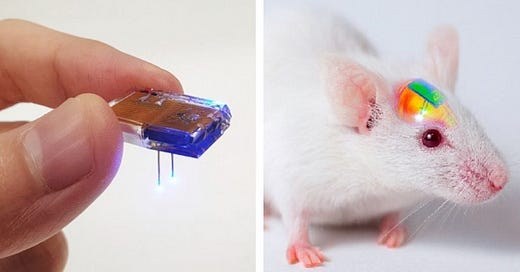This week we will examine some 3D printed bones, an implant that can help manage degenerative brain diseases and an AI that automatically dubs movies in multiple languages in the voice of the original actor. We also look at a new Hydrogen Battery that will store power from solar cells in the home or in a business.
3D Printed Bones
In 2016 researchers at Northwestern University (Chicago) announced that they had developed a scaffolding material that used hydroxyapatite (a mineral in bones) and polycaprolactone (a polymer) to build a bone replacement material that was not rejected by the body.
Now a team at the University of New South Wales has developed a ceramic ink that can be 3D printed with live cells (and without the dangerous chemicals that are usually used in this process). The team claims that this new ceramic ink will allow bones to be printed during an operation. The ink is in the form of a paste at room temperature but once put into a gelatin bath it hardens into a nanocrystal structure similar to the structure of bone tissue.
The process will eventually replace bone grafts that are prone to high rates of infection and are unsuitable if the bone material required is too big. The researchers are now attempting to print larger structures and test on animals to test the effectiveness of the 3D printed bone parts.
Brain Implant to treat Disorders
Researchers from the Korea Advanced Institute of Science and Technology have developed a smart phone controlled soft brain implant that is able to be wirelessly recharged. The device is designed to enable long term neural circuit manipulation whilst removing the need for periodic surgery to replace the implant’s battery.
The implant is designed for use in the treatment of neurodegenerative diseases such as addiction, depression and Parkinson’s Disease.
The device is made out of ultra soft and bio compliant polymers that enable long term compatibility with live tissue. LED’s the size of a grain of salt are mounted on ultra thin probes (the width of a human hair). These allow the device to wirelessly manipulate target neurons via light in the deep brain.
The team successfully tested the implant on rats where they were able to suppress cocaine induced behavior in rats injected with cocaine.
AI dubbed Movies
If we ever watch a movie that was filmed in a language we don’t speak we either have to read subtitles or listen to a badly dubbed translation of the words. Israeli startup, deepdub.ai is solving this problem with AI.
They have developed an AI that will translate the voice track of a movie into a different language whilst staying true to the voice of the actor. For example, Morgan Freeman has a very distinctive voice. Deepdub will translate a movie that he is in, into French, Russian or Italian with losing what makes Freeman’s voice special and recognizable.
Their demonstration video on Youtube gives you an idea of what the technology can do. They can currently dub videos into six different languages (including French, German and Spanish). The aim is to expand that to 60 languages allowing streaming services to show movies all around the world that are truly localized.
There are number of startups working to automate voice translation. Toronto based startup Resemble has released a tech that can clone your voice in different languages. London startup Synthesia not only changes the voice track, it also adds deep fake video manipulation to match an actor’s mouth to the new voice.
Hydrogen Home Battery
Australian startup Lavo has released a hydrogen battery for home and business use. Developed at the University of New South Wales the battery takes power from your solar panels and splits water into hydrogen and oxygen. The hydrogen is then stored in a metal hydride (the oxygen is released to the air). When power is needed it is generated via a fuel cell (which combines hydrogen and oxygen from the air to create water, excess chemical energy is captured the form of electricity and used to power the home).
The system is about the size of a large fridge and can store 3 times the power that Tesla’s Powerwall can store. A total of 40 Kilowatt hours of power can be stored, enough to power an average home for 2 days. A small 5 kilowatt lithium battery is included to allow instantaneous response. At AU$34,750 it is not cheap however price is certain to drop over time. The product will be released internationally in late 2022.
Paying it Forward
If you have a start-up or know of a start-up that has a product ready for market please let me know. I would be happy to have a look and feature the startup in this newsletter. Also if any startups need introductions please get in touch and I will help where I can.
If you have any questions or comments please email me via my website craigcarlyon.com or comment below.
I would also appreciate it if you could forward this newsletter to anyone that you think might be interested.
Till next week.





